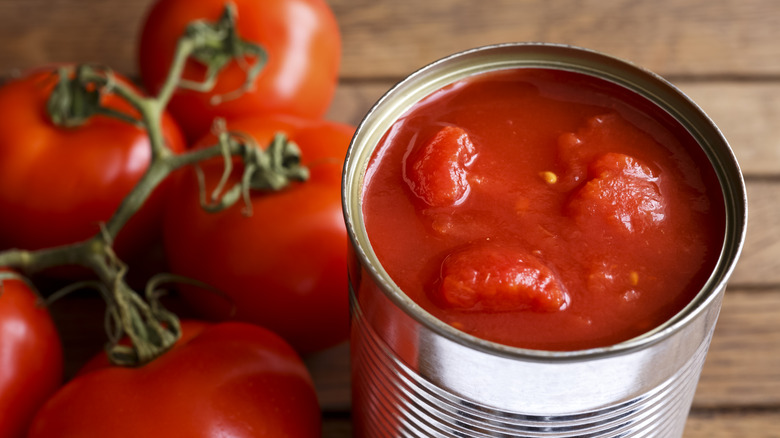What To Check On The Label Before Buying Canned Tomatoes
These days, canned tomatoes come in countless varieties. You can buy them pre-diced, peeled, stewed, or crushed for your cooking convenience. You can even buy whole canned tomatoes in juice or puree and do with them whatever you please. Regardless of the style you choose, however, it's worth taking a second look at the label to make sure you're getting a quality product that tastes and cooks down the way you want it to.
First, you'll want to determine how the tomatoes were peeled. Usually, canned tomatoes are blanched and steam peeled. This method is ideal, as it's more gentle than others, and leaves the tomatoes intact, colorful, and as close to the texture of fresh tomatoes as you can get. Since only water is used, steam peeling is also relatively eco-friendly. Many brands will specify on their labels if they use steam peeling as their processing method.
A slightly more abrasive method is when canned tomatoes are treated with lye to remove their peels. Though lye is permitted in the processing of organic products, lye itself is not an organic substance. Rather, lye is considered a caustic chemical and actually requires expensive treatment before it can be disposed of safely. This peeling process also renders the tomato skins unusable in other products.
Keep an eye on the ingredients list
When it comes to canned tomatoes, products vary widely in terms of preservatives and other additives. For instance, certain styles of canned tomatoes might contain a firming agent called calcium chloride. Depending on your particular recipe or personal preferences, the presence of calcium chloride may not be a big deal, but you should keep in mind that it prevents tomatoes from breaking down — both in the can, and during cooking. Others might contain citric acid to preserve the tomatoes' color. Of course, many canned tomatoes also contain sodium for preservation purposes, but the amount may be more than you'd like, and cause them to taste overly salty.
You might find that other brands include flavor additives in their canned tomatoes, such as basil, garlic, oregano, peppers, or onion. In some cases, these extra flavors might save you some time in the kitchen, but they're a far cry from the blank canvas other recipes require. Instead, when perusing the shelves for canned tomatoes, look for the can with the fewest ingredients. These tomatoes — usually whole, peeled tomatoes — will be the easiest to work with in terms of both texture and flavor, as they're the closest you can get to fresh tomatoes. You're essentially starting from scratch, and that can greatly benefit many recipes.
Cooking with canned tomatoes
How you cook with canned tomatoes very much depends on how they've been processed and what ingredients they include. Canned tomatoes that have been treated with calcium chloride, for instance, will not cook down into a paste or sauce. Instead, these styles (typically diced or cubed) are best used in recipes that don't mind tomato chunks — such as salsa, pico de gallo, chili, soup, stew, curry, and, of course, all sorts of pasta dishes.
Whole tomatoes, on the other hand, are much more versatile. They can be cooked down into a sauce, pureed, or diced as you please. Homemade marinara? Yes, please. These canned tomatoes also generally contain fewer ingredients (in terms of flavor additives), so you can easily enhance them with any spices or seasonings without worrying about any pre-existing flavors clashing with those of your finished dish.
Alternatively, canned tomato puree eliminates the need to cook tomatoes down, as they've already been crushed to a pulp and strained of excess moisture. This product has a concentrated tomato flavor and a smoother texture than that of tomato paste, making it perfect for soups and sauces.



